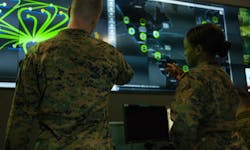WRIGHT-PATTERSON AFB, Ohio – U.S. Air Force Researchers are ready to kick-off a potential $98 million project to fast and efficient ways to move enabling technologies for machine autonomy from the laboratory to flight testing.
Officials of the Air Force Research Laboratory at Wright-Patterson Air Force Base, Ohio, issued a presolicitation Friday (FA8650-21-S-1017) for the Soaring Otter program to speed development and deployment of machine autonomy enabling technologies like artificial intelligence (AI), machine learning, neural networks, neuromorphic computing, and data exploitation.
The Air Force (AF) increasingly is employing machine autonomy to solve complex problems related to global persistent awareness, resilient information sharing, and rapid decision making, researchers say. Enabling technologies include autonomy algorithms, hardware, and software to support autonomy.
Although these new computing solutions bring new capabilities, but they also confront systems designers with challenges like how best to develop applications and integrate them into military applications like target identification and recognition; positioning, navigation and timing (PNT); and unmanned aerial vehicle (UAV) route planning.
The problem revolves around how to integrate and test these new solutions with acceptable costs and risks; there is need for a well-defined progression from lab prototype, through realistic system integration lab testing, and finally through field and flight testing.
The Soaring Otter project seeks to capitalize on the latest advancements in autonomy and machine learning in six areas: autonomy development and testing; evaluation of autonomy capabilities; computing approaches; new application areas; open-systems architectures for autonomy; and autonomy technology integration and testing.
Autonomy development and testing seeks to solve autonomy problems with machine learning, neural networks, and AI by maturing existing technologies, and determining early what is necessary to switch these autonomy technologies to the warfighter.
Related: Artificial intelligence and embedded computing for unmanned vehicles
Evaluation of autonomy capabilities seeks to provide neutral third-party evaluation of algorithms from government, academia, and industry.
Novel computing approaches focuses on compact computing solutions for the warfighter operating on the edge of the battlefield. New application spaces, meanwhile, seek to determine where autonomy can bring the greatest benefit in intelligence, surveillance, and reconnaissance (ISR) applications.
Open-systems architectures for autonomy will be fundamental elements of future autonomous systems. Autonomy technology integration and testing, finally, seeks new ways of integrating new autonomy technologies into larger systems for laboratory, field, and flight testing.
A formal solicitation for the Soaring Otter program is expected in January 2021. The program should last for five years, and will be conducted at the top secret level.
Email technical questions to the Air Force's Kelly Miller at [email protected], or contracting questions to Jennifer Skalski at [email protected].
More information is online at https://beta.sam.gov/opp/78550e0901a84d7fa1d4d595570e2913/view.



